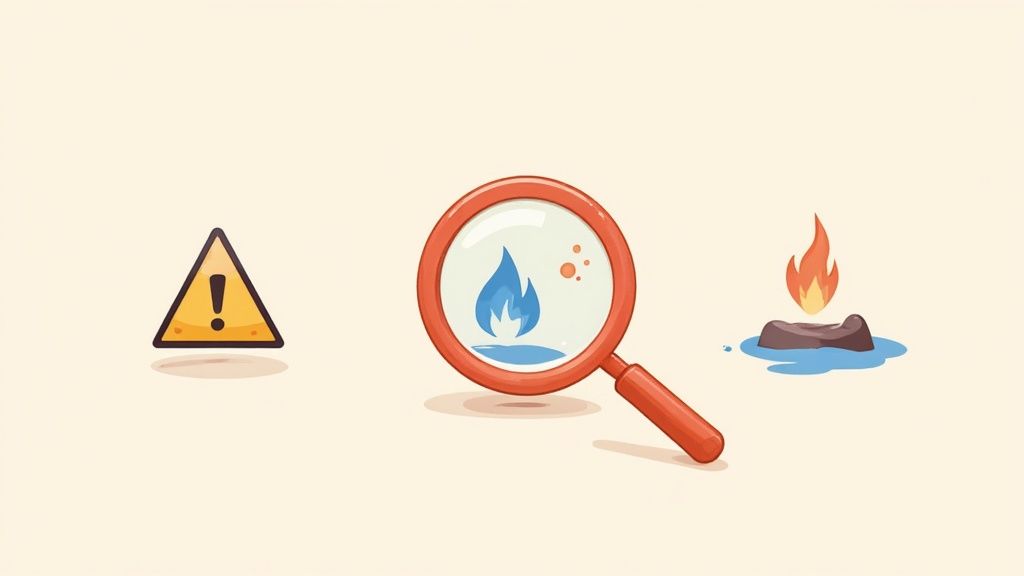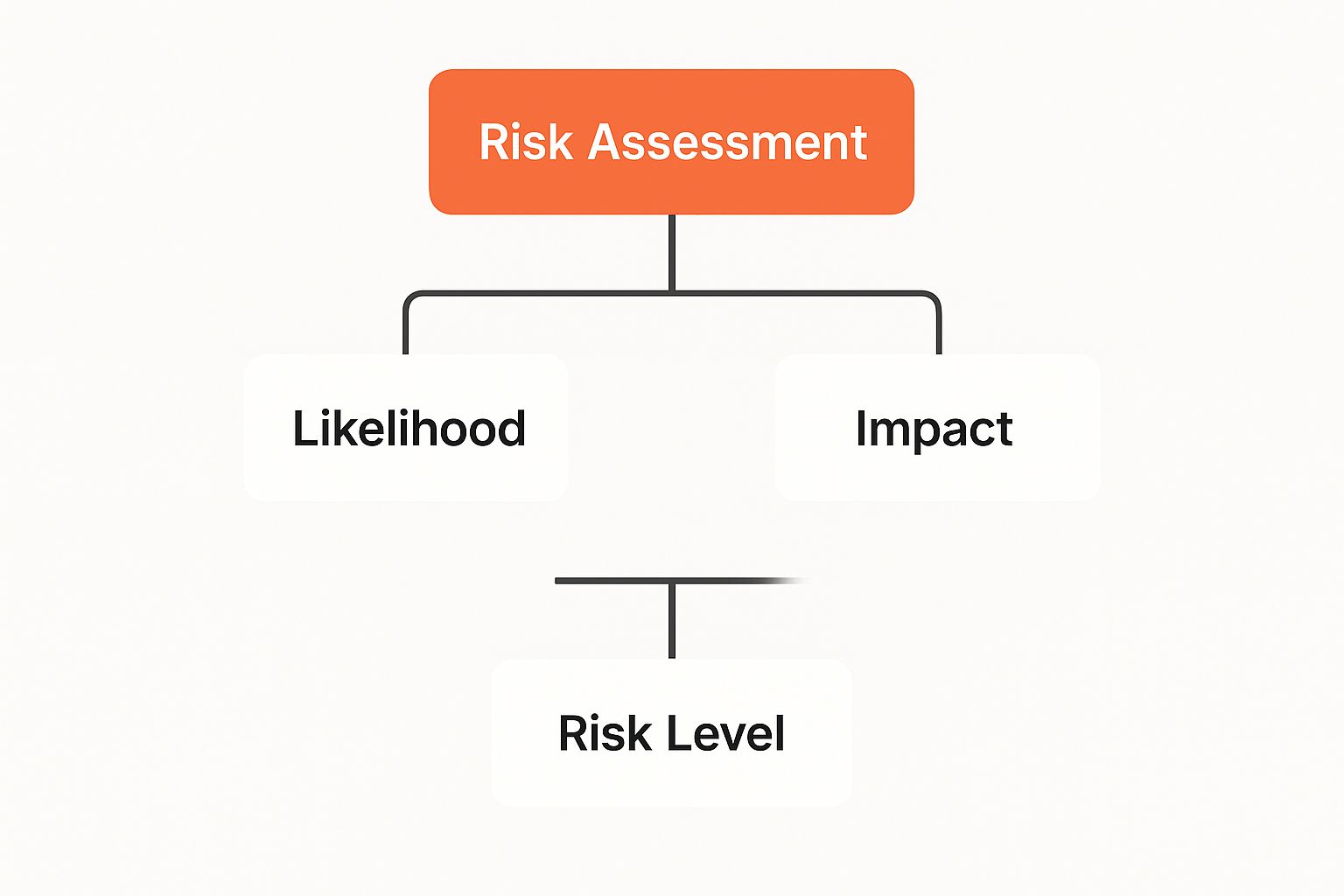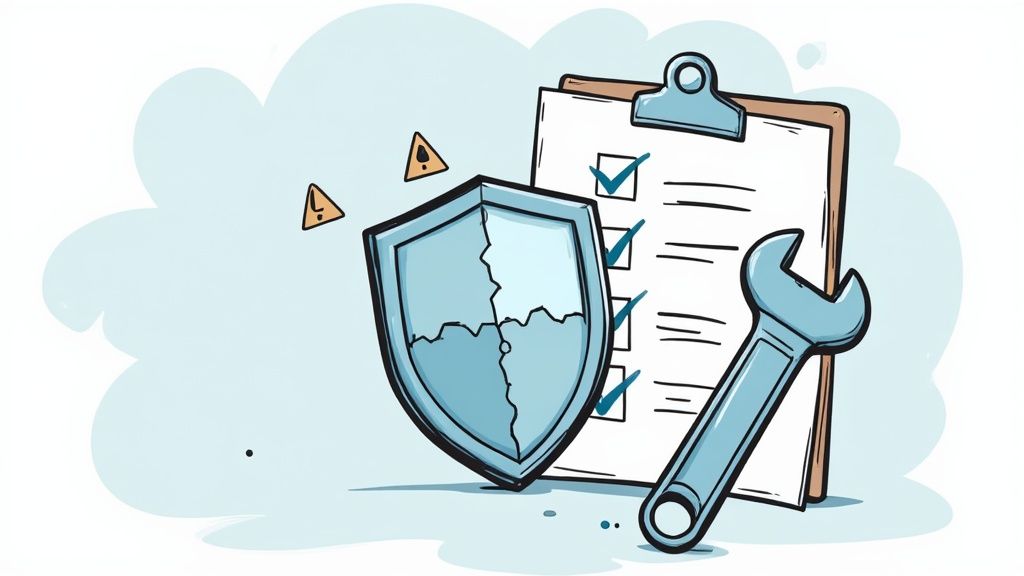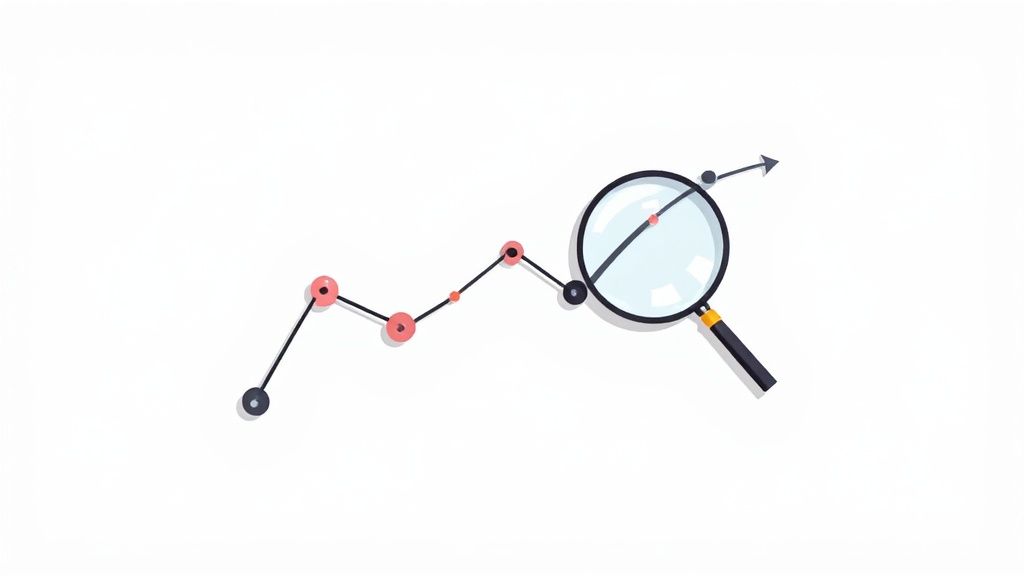Risk control measures are the actions you take to either get rid of a workplace hazard or reduce the harm it could cause. It's the practical, hands-on part of any good risk management plan.
Think of it this way: putting a "wet floor" sign next to a spill is one thing. Actually mopping up the spill is another. One just warns of the danger, while the other removes it completely. That’s the core idea behind risk control.
What Are Control Measures in Your Workplace?

Control measures are your planned responses to the risks you’ve found on site. After you spot the hazards, you have to decide what to do about them. This isn't about creating more paperwork; it’s about putting real-world solutions in place to protect your team and keep the job running.
These solutions can be surprisingly varied. For example, if a machine is kicking out chemical fumes, a control measure could be installing a ventilation system to pull the fumes away from your workers. Or, if a walkway is constantly cluttered with tools, a control measure might be as simple as painting clear lines on the floor and training staff to keep that path clear.
The Goal of Risk Controls
The main goal is to make the work environment as safe as it can be. This requires a systematic approach, not guesswork. You can’t control what you haven’t found, which is why a solid process for hazard identification is the essential starting point. Once you know what the dangers are, you can pick the right tools for the job.
It helps to categorize these actions based on how effective they are. A good way to start is by ranking them to see which ones give you the most protection.
The most effective control measures are the ones that tackle the risk at its source, either by removing the hazard entirely or making it impossible for anyone to get near it. Relying on people to just "be careful" is the least reliable method.
An Overview of Control Levels
To help visualize this, think about the different types of actions you can take. They range from highly effective, permanent fixes to less reliable measures that depend on people remembering what to do. For managing risks from outside your immediate work area, putting up physical barriers like temporary fencing for construction sites is a classic and crucial control measure for both safety and site access.
Here's a quick look at the different levels of risk controls, which we'll cover in more detail throughout this guide.
Quick Overview of Risk Control Levels
This table summarizes the different types of risk control measures, ranked from most effective to least effective.
| Control Level | Action | Effectiveness |
|---|---|---|
| Elimination | Physically remove the hazard | Most Effective |
| Substitution | Replace the hazard with a safer alternative | Very Effective |
| Engineering | Isolate people from the hazard | Effective |
| Administrative | Change the way people work | Moderately Effective |
| PPE | Protect the worker with personal equipment | Least Effective |
As you can see, the most powerful controls are those that permanently solve the problem, while the weakest rely on human action. We'll explore each of these in more detail next.
Understanding the Hierarchy of Controls
When you're trying to control a risk, there’s a tested framework that organizes your options from most effective down to least reliable. It’s called the Hierarchy of Controls, and it’s your guide for making practical decisions to keep people safe.
Think of it as a ladder. You always want to start at the highest rung because it offers the most solid protection. Only when a higher-level control isn’t reasonably practical should you move down to the next best option.
The diagram below shows how the hierarchy fits into a risk assessment. You look at how likely an incident is and what its potential impact could be, which helps you pinpoint the right control measure.

As the visual shows, a proper risk assessment is the foundation. Let's walk through each level of the hierarchy using a common manufacturing example: a machine that's dangerously loud.
Elimination: The Best Possible Fix
The most powerful control measure is always elimination. It means you physically remove the hazard from the workplace entirely. It’s a permanent solution that stops the problem right at the source.
For our loud machine, elimination would mean getting rid of it and the noisy process altogether. Maybe the part it produces can be bought from an external supplier, or perhaps the task can be done using a completely different, silent method.
The Elimination Principle: If the hazard isn't there, it can't cause harm. This should always be your first thought for any risk you identify.
Substitution: A Safer Alternative
If you can't completely eliminate the hazard, the next best thing is substitution. This is about replacing the hazardous process, material, or equipment with a safer alternative that gets the same job done.
In our noisy workshop, this would mean replacing the old, clattering machine with a modern, quieter model. The work still gets done, but the risk of hearing damage is reduced for everyone nearby.
Engineering Controls: A Physical Barrier
When you can’t get rid of the hazard or swap it out, you bring in engineering controls. These are physical changes to the workplace, equipment, or process that isolate people from the danger. The benefit of these controls is that they don’t rely on people changing their behavior to be effective.
For the loud machine, a classic engineering control would be building a soundproof enclosure around it. Workers can still operate the machine from the outside, but the physical barrier blocks the dangerous noise from reaching their ears. This solution provides collective protection for everyone in the area.
This systematic approach isn’t just for individual workplaces. Organizations like the Africa Centres for Disease Control and Prevention use internationally recognized frameworks like ISO 31000 to manage health security risks across the continent. It shows that a structured policy is key, whether you're managing one machine or a national-level risk.
Administrative Controls: Changing How People Work
Next on the ladder are administrative controls. These controls change the way people work around a hazard by creating specific procedures, rules, or training programs. They are considered less effective because they depend on people remembering and consistently following instructions.
Applied to our noisy machine, an administrative control might involve limiting how long a worker can spend in that area. This could mean job rotation, where workers move to quieter tasks after an hour, or scheduling the noisy work for times when fewer people are around.
Personal Protective Equipment: The Last Resort
Right at the bottom of the hierarchy is Personal Protective Equipment (PPE). This includes things like hard hats, gloves, safety glasses, and, in our example, earplugs or earmuffs.
PPE is always the last line of defense. Why? Because it only protects the individual wearer and does nothing to remove or reduce the actual hazard. If the equipment fails, is worn incorrectly, or isn't used at all, the worker is completely exposed to the risk. While PPE is often necessary, it should never be the first or only control measure you rely on.
For more information, check out our guide on personal protective equipment requirements.
How to Select the Right Control Measures

Knowing the different types of controls is one thing; picking the right one for a specific job is where it gets real. Choosing the best way to manage a risk isn't about finding a one-size-fits-all solution. It’s a methodical process that balances giving your team maximum protection with practical things like cost and how the work gets done.
The selection process should always start with the Hierarchy of Controls we just talked about. Your goal is to work from the top down, aiming for the most effective control that is reasonably practicable for your workplace.
A Practical Decision-Making Process
Let's walk through a common construction scenario to see how this works. Imagine your team needs to work on the second story of a new build. The obvious hazard is working at height.
- Identify the Hazard: The clear danger is a fall from an unprotected edge.
- Assess the Risk: A fall from that height is highly likely to cause serious injury or death. The risk is severe.
- Consult the Hierarchy: Now, you apply the hierarchy to find the best control.
Could you eliminate the risk? Maybe, if the work could be done on the ground and then lifted into place. But let's assume the crew has to be up there. Substitution isn't really an option here, so we move down the ladder.
The best and most practical choice is an engineering control. Installing permanent or temporary guardrails around all open edges physically separates workers from the hazard. This is a great example of collective protection; it protects everyone in the area without them needing to do anything special.
If for some reason guardrails aren't possible, you might look at administrative controls like ‘no-go zones’ marked with tape. But this is far less reliable. And finally, relying solely on PPE like a harness and lanyard system is your last resort. It only protects one person, requires extensive training to use correctly, and introduces multiple points of potential failure.
Guardrails protect everyone automatically. A harness only protects one person, and only if it’s used perfectly every time. This is exactly why engineering controls are a better choice than relying on PPE alone.
Comparing Controls for Common Hazards
This thought process applies to pretty much any hazard you'll encounter on site. To make it a bit easier to visualize, the table below compares different control measures for common industrial risks. Think of it as a quick reference guide to get your thinking started when you're deciding on the best way forward.
Comparing Control Measures for Common Hazards
This table shows a practical comparison of different control measures applied to typical workplace risks.
| Hazard | Engineering Control | Administrative Control | PPE |
|---|---|---|---|
| Airborne Dust | Install a local exhaust ventilation (LEV) system to capture dust at the source. | Limit exposure time for workers in dusty areas and use wet-cutting methods. | Provide workers with correctly fitted respiratory masks (e.g., P2 masks). |
| Manual Handling | Use mechanical aids like forklifts, trolleys, or conveyor belts to move heavy loads. | Train workers in safe lifting techniques and break down large loads into smaller ones. | Issue steel-capped boots and high-grip gloves to workers. |
| Chemical Spills | Store chemicals in bunded pallets or cabinets that can contain spills. | Implement strict procedures for handling and decanting chemicals; provide spill kits. | Require workers to wear chemical-resistant gloves, aprons, and safety goggles. |
A clear pattern emerges. The most robust controls are those that physically change the work environment to make it safer for everyone involved.
Implementing and Monitoring Your Controls
Putting the right control measures for risks in place is a solid first step, but it’s only half the job. A plan on paper does nothing to stop an accident. You need a practical, step-by-step process for getting the control working on the floor and a system for checking that it’s actually doing what you intended.
A clear implementation plan is essential. It should outline exactly who is responsible for what, the specific training needed for the new process or equipment, and a realistic timeline. Without these details, even the best ideas can fall flat.
From Plan to Action
Let's use a manufacturing example. Imagine your risk assessment identified a hazardous chemical used for cleaning machine parts. Following the Hierarchy of Controls, you’ve decided on substitution and found a safer, non-toxic alternative.
Here’s what a simple implementation plan would involve:
- Assign Responsibility: The Warehouse Manager is responsible for removing all stock of the old chemical by the end of the week. The Production Supervisor is responsible for training staff on the new product.
- Update Procedures: All Safe Work Method Statements (SWMS) and safety data sheets related to the cleaning process must be updated to reflect the new chemical.
- Conduct Training: Organize short, practical training sessions for all workers who will use the new cleaner, covering correct usage, storage, and any new PPE requirements.
- Set a Deadline: The new chemical must be in full use across the site by the 15th of the month.
Checking Your Controls Are Working
Once your control is in place, you need to confirm it’s effective. The goal is to reduce risk, not accidentally create new problems. Monitoring isn't a one-off task; it’s an ongoing process to ensure your workplace stays safe.
A control measure that isn't checked is just an assumption. You need to actively look for evidence that it's working as planned and that workers are following the new procedures correctly.
This verification process can be built into your existing operations. It’s a core part of any good safety management system and doesn’t need to be complicated.
Key monitoring activities include:
- Regular Inspections: Are the new guardrails still secure? Is the ventilation system clean and running correctly?
- Worker Feedback: Ask the people on the ground. They are the first to know if a new process is clumsy or if a control isn't practical.
- Incident Reports: Keep an eye on near misses and accident reports. A spike in minor incidents could signal that your new control isn't as effective as you thought.
This systematic approach to risk reduction is a global priority. For example, the African Union Commission is developing a continent-wide framework to reduce disaster losses, showing the importance of structured risk control at every level. Learn more about the Africa Common Position for Disaster Risk Reduction. By constantly checking and adjusting, you ensure your controls remain effective.
Common Challenges and How to Overcome Them

Knowing the best control measures for a risk is one thing. Actually getting them implemented in the real world is another. Even the best safety plans can run into roadblocks like tight budgets, resistance from the team, or a lack of backing from the top.
These hurdles are normal, but they need to be handled head-on to keep your safety efforts on track. If you ignore them, you'll end up with controls that look good on paper but leave your team exposed to preventable harm.
Overcoming Budget Constraints
One of the first objections you'll hear is cost. A top-tier engineering control, like a custom-built ventilation system, can have a hefty price tag. When the budget is tight, it’s tempting to skip straight to cheaper options like PPE.
But that's rarely the safest or most cost-effective choice in the long run.
Instead of giving up on better controls, try these practical steps:
- Focus on Low-Cost, High-Impact Controls: You can make a huge difference with administrative controls. Think about improving work procedures, creating clear exclusion zones, or rotating jobs to limit exposure. These are often inexpensive and quick to implement.
- Build a Solid Business Case: Show management how the upfront cost of a control measure prevents much larger costs down the line. Do the math. Calculate the potential savings from avoiding lost time, worker compensation claims, and equipment damage.
A single serious injury can cost a business tens of thousands of dollars. That number dwarfs the initial investment in a proper engineering control. Prevention is almost always cheaper than reaction.
Financial limits are a universal problem in risk management. For example, risk control within the African Union has faced ongoing difficulties with financing, which in turn impacts the ability to retain skilled staff and run effective programs.
Managing Employee Resistance
Sometimes, the biggest challenge comes from the people the controls are designed to protect. Workers might see a new procedure as a pain, or a new guard on a machine as something that just slows them down. This resistance is a threat to the effectiveness of any control measure.
The key to getting past this is involvement.
When you include the workers who do the job in the decision-making process, two things happen. You get useful insights, and you build a sense of ownership. Ask for their input on what would work best on the floor. They often have practical ideas that managers would overlook.
This collaborative approach turns them into partners in safety, not just subjects of new rules. Understanding these human-factor challenges is just as crucial as the technical ones, whether you're on the factory floor or Mastering Supply Chain Risk Management.
Got Questions? We’ve Got Answers.
When it comes to putting risk controls into practice, a few questions pop up time and time again. Let's get straight to the practical answers you need.
What’s the single most effective control measure?
Without a doubt, the most effective control measure is elimination.
It’s number one on the Hierarchy of Controls for a simple reason: it's the only one that gets rid of the hazard completely. If the hazard isn't there, an accident simply can't happen. It’s the ultimate form of protection.
Of course, elimination isn't always possible. You can't just eliminate welding in a metal fabrication workshop, for instance. That’s why the hierarchy is there. If you can't get rid of the hazard, you move down a step to find the most effective solution that is possible, like using engineering controls to extract weld fumes at the source.
Always start by asking one simple question: "Can we get rid of this hazard entirely?" If the answer’s no, you work your way down the list to find the next most effective control.

How often should we review our risk controls?
There’s no one-size-fits-all answer here. The right frequency depends on your specific situation, the level of risk, and how often your work environment changes.
Think of it less like a fixed schedule and more like a set of triggers. You should review your controls when:
- You're dealing with high-risk activities. Anything particularly dangerous, like working in a confined space, needs its controls checked often, sometimes even before every single shift.
- An incident or near-miss occurs. This is a massive red flag. Any incident means a control either failed or wasn't good enough in the first place, and an immediate review is non-negotiable.
- Your workplace changes. Bringing in new equipment, changing a process, or even just welcoming new team members means you need to double-check that your existing controls are still up to the job.
- It’s time for a scheduled check-in. For everything else, a routine annual review is a good rule of thumb. It helps you catch any issues that might have crept in.
Regular reviews are what keep your safety measures from becoming just another piece of paper.
Can we use more than one control measure for a single risk?
Yes, and you absolutely should. Layering multiple control measures for one risk is one of the smartest things you can do. It creates overlapping protection, making your safety system far more resilient.
Take a machine with dangerous moving parts as an example. Instead of just doing one thing, you could:
- Fit a permanent physical guard over the pinch points (an engineering control).
- Train your team on safe operating and lockout/tagout procedures (an administrative control).
- Require operators to wear snug-fitting gloves to prevent them from getting caught (PPE).
Now you’ve got several layers of defense. If someone forgets a procedure, the physical guard is still there to stop them from getting hurt. It’s a practical approach that builds a robust safety plan for those risks where one solution just isn't enough.
Ready to stop juggling spreadsheets and paper forms? Safety Space is the all-in-one platform that simplifies your health and safety management. It gives you real-time oversight and helps you spot problems before they become incidents. Book a free demo to see how you can build a safer, more efficient workplace.
Ready to Transform Your Safety Management?
Discover how Safety Space can help you build a safer, more compliant workplace with our comprehensive safety management platform.
Book a Free DemoRelated Topics
Safety Space Features
Explore all the AI-powered features that make Safety Space the complete workplace safety solution.
Articles & Resources
Explore our complete collection of workplace safety articles, tools, and resources.
